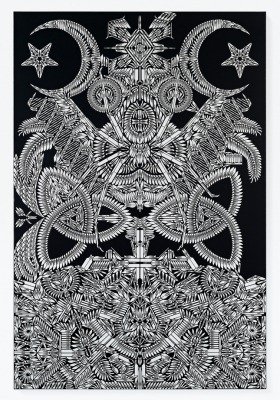Damien Hirst
dal 20/2/2013 al 3/5/2013
Segnalato da
20/2/2013
Damien Hirst
White Cube, Hong Kong
The exhibition features cabinets and paintings from the 'Entomology' series as well as 'Scalpel Blade Paintings', in which he uses assemblage and formal arrangement as their leitmotifs, and 'Colour Charts', that rely on colour theory as the organisational tool for their compositions, which form some of the artist's newest work.

White Cube Hong Kong is pleased to present an exhibition of new work by Damien Hirst. This exhibition will feature cabinets and paintings from the ‘Entomology’ series, begun in 2009, as well as ‘Scalpel Blade Paintings’ and ‘Colour Charts’, which form some of the artist's newest work. Hirst is known for his use of uncompromising materials to directly address profound and fundamental questions about existence and this exhibition furthers his investigation into such thematic dualities as life and death, desire and fear, beauty and horror.
The ‘Entomology Cabinets and Paintings’ employ one of Hirst's most iconic and familiar motifs – the butterfly – and re-presents them interspersed with thousands of highly coloured insects and spiders. Hirst was drawn to them because, like butterflies, they embody the fragility of life, retaining an iridescent beauty even when dead. In the cabinets, beetles, butterflies and other insects are placed in precise, vertical or horizontal rows inside minimal and reflective, wall-mounted stainless steel frames. With each species arranged in separate rows, the overall effect is one of scientific ordering or industrial production.
However, on closer inspection, this is undone by the slight mis-registration of their placement and small, subtle variations within each group. In the ‘Entomology Paintings’, Hirst has used similarly colourful insects in intricately patterned symmetrical compositions on Hammerite gloss paint. Like the cabinets, these vivid and colourful tableaux allude to both the opulent patterning and symmetry that exists in the natural world and to the 'cabinet of curiosities', or Victorian-era Natural History displays where decorative visual effect was as important as scientific categorisation.
The ‘Entomology Paintings’ relate closely to Hirst's earlier ‘Kaleidoscope Paintings’ – where thousands of butterfly wings were arranged on canvases shaped like gothic stained-glass windows – but are altogether darker in theme, alluding to zoological collections and titled after characters and locations from the Divine Comedy (c.1308-1321), Dante's torturous vision of the underworld.
In the ‘Scalpel Blade Paintings’, Hirst continues his use of scientific and medical iconography, placing thousands of different types of scalpel blades in spectacular, mandala-like patterns. Some of these paintings are starkly monochromatic; their surfaces accentuated by the light that refracts off each carefully-angled blade, while others are intermittently layered with brightly coloured gloss paint, reminiscent of the psychedelic imagery and freedom of colour more associated with folk art.
With the material transformation of a standard medicinal tool, these works relate to Hirst's early instrument cabinets from the 1990s, in which thousands of precision-tooled surgical instruments were arranged in a formal and aesthetically pleasing manner, to create works whose beauty masked the inescapable futility of medicine in the face of our own mortality.
While both the ‘Entomology Paintings’ and ‘Scalpel Blade Paintings’ use assemblage and formal arrangement as their leitmotifs, the ‘Colour Charts’ rely on colour theory as the organisational tool for their compositions. Like Hirst's infamous ‘Spot Paintings’, these works optimise the energy created by colour juxtaposition and employ a systematic approach to its application. Precisely executed in brilliant gloss paint, using primary, secondary and tertiary colours, these bold, Pop-like paintings harness the power of colour to create canvases with a vibrant energy and optical beauty.
Damien Hirst was born in 1965 in Bristol, UK. He lives and works in London, Gloucestershire and Devon. He has participated in numerous group exhibitions including ‘Our Magic Hour’, Yokohama Triennale, ‘The Luminous Interval’, Guggenheim Museum, Bilbao, ‘Modern British Sculpture’, Royal Academy of Arts, London (all 2011); ‘Pop Life’, National Gallery of Canada, Ottawa, Hamburger Kunsthalle (both 2010) and Tate Modern, London (2009); ‘Barock’, MADRE, Naples (2009); ‘Color Chart’, Museum of Modern Art, New York, Broad Contemporary Art Museum and LACMA, Los Angeles (all 2008); ‘Play Back’, Musée de la Ville de Paris (2007), ‘Re-Object’, Kunsthaus Bregenz (2007), ‘Into Me / Out of Me’, P.S.1 Contemporary Art Center, New York (2006), ‘In-A-Gadda-Da-Vida’, Tate Britain (2004), the 50th Venice Biennale (2003) and ‘Century City’, Tate Modern, London (2001).
Solo exhibitions include ‘Cornucopia’, The Oceanographic Museum of Monaco (2010), ‘No Love Lost’, The Wallace Collection, London (2009), ‘Requiem’, Pinchuk Art Centre, Kiev (2009), ‘For the Love of God’, Rijksmuseum, Amsterdam (2008), Astrup Fearnley Museet fur Moderne Kunst, Oslo (2005), Museum of Fine Arts, Boston (2005) and ‘The Agony and the Ecstasy’, Archaeological Museum, Naples (2004). An exhibition of the artist’s private collection, ‘Murderme’, was held at Serpentine Gallery, London in 2006. He received the DAAD fellowship in Berlin in 1994 and the Turner Prize in 1995. In 2012, Tate Modern exhibited the most comprehensive survey of Damien Hirst’s work ever held in the UK.
Opening: 21 February 2013
White Cube
50 Connaught Road Central, Hong Kong
Hours: Tuesday – Saturday, 11am – 7pm
Free Admission



